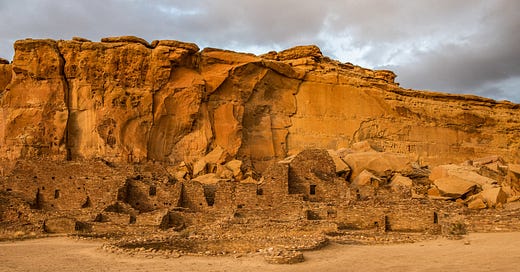Cosmic Canyon: Celestial Reflections on the Third Stone from the Sun - Part 7 of 10 LoRaS
TEMJ 20560 - Chaco Canyon, Puebloans, Architecture, Kivas, Great Houses, Room Blocks, Core and Veneer, Timber Transport, Trade Network, Chaco Meridian, Celestial Alignment, Fire Box, Mica Mirror
Greetings Fellow Earthmonks,
Welcome to the Earthmonk Journal, your passport to the extraordinary stories of people and places. In each edition of The Earthmonk journal we will explore nature's wisdom and it’s wonders! Join me as we traverse landscapes of discovery, guided by curiosity, and fueled by passion for the wild. So grab your metaphorical backpack and embark on an unforgettable adventure with me.
The Language of Rocks and Stones
In the "The Language of Rocks and Stones”, LoRaS series we will travel across continents and cultures. Each edition in the series will explore the spiritual, cultural, and ecological significance of geological formations to the indigenous peoples who revere them. This series is not just an exploration of geology; it is an invitation to connect more deeply with the spiritual essence of the land and to honor the ancient wisdom that continues to guide us in our stewardship of the earth. We will delve into how these rocks and stones are more than mere physical entities; they are living, breathing parts of a larger cosmology, integral to ceremonies, storytelling, and the very identity of these cultures.
Throughout the 10 part LoRaS series, we aim to illuminate the profound wisdom embedded in these traditions, highlighting the ways in which indigenous peoples have communicated with and interpreted their natural surroundings. We will uncover how sacred sites are chosen, how rituals and ceremonies are conducted, and how stories and legends have been passed down through generations, all centered around these magnificent geological formations. This series delves into the rich and profound relationships that indigenous peoples around the world have with the geological features of their homelands.
Join me as we embark on this journey to understand the "Language of Rocks and Stones." Through the voices of elders, spiritual leaders, and cultural custodians, we will learn to see the world through the eyes of those who have long understood the sacred relationship between the earth and its inhabitants.
"In each pebble, a story; in every stone's journey, a memory unfolds."
- Alfonso Ortiz, a respected Pueblo historian and anthropologist
Chaco Culture National Historical Park, USA
The Puebloans
Today, Chaco Canyon is recognized as a UNESCO World Heritage Site and is preserved as part of the Chaco Culture National Historical Park. The site continues to be a focus of archaeological research, revealing new insights into the lives of the Ancestral Puebloans and their remarkable achievements. For the modern Puebloan tribes, Chaco remains a living cultural landscape, a place of pilgrimage, and a testament to the resilience and ingenuity of their ancestors.
The ethno-history of the Puebloan people and Chaco Canyon is a deeply woven narrative that spans centuries, rooted in the rich cultural and spiritual traditions of the indigenous peoples of the American Southwest. This history reflects the Puebloans' intricate relationship with the land, their sophisticated understanding of astronomy, and their enduring legacy as one of the most complex societies in pre-Columbian North America.
The Puebloan people, often referred to as the Ancestral Puebloans or Anasazi (a term now less favored), trace their origins back thousands of years. Their ancestors were hunter-gatherers who gradually transitioned to a more settled agricultural lifestyle, cultivating crops like maize, beans, and squash. By around 200 CE, these early communities began to develop more permanent settlements, marking the beginnings of the distinct Puebloan culture.
"For the Pueblo people, every part of the landscape is sacred. The stones, the cliffs, the mountains—each holds a spirit, a memory of our ancestors, and a connection to the Creator. Chaco Canyon is not just a place; it is a living entity, where the stones themselves speak to those who listen."
Alfonso Ortiz, a respected Pueblo historian and anthropologist
Keep reading with a 7-day free trial
Subscribe to The Earthmonk Journal to keep reading this post and get 7 days of free access to the full post archives.




